While in the publications that accompany exhibitions it is natural to expect contributions that shed light on the motivations that led to the conception of the exhibition (or at least, this is what is normally expected from an exhibition based on a serious scientific project), it is not as common to find, in the catalog of an exhibition, an essay written by the curator that tells the reader how the exhibition project was born, what the phases of the realization and operation of the exhibition were, what the reasons that led to the choice of the exhibition venue, what difficulties were encountered along the way. Most significant in this regard is the example offered by the exhibition Lorenzo Lotto. The Lure of the Marche. Places, Times and People, scheduled from October 19, 2018 to February 10, 2019 in Macerata at Palazzo Buonaccorsi. The dense catalog of the Marche exhibition opens with an essay by curator Enrico Maria Dal Pozzolo, titled Progetto Lotto, with which the reader is informed not only about the reasons behind the exhibition, but also about everything related to the organization of the exhibition itself, with a sort of chronicle of the months leading up to the opening of the doors of Palazzo Buonaccorsi. And since the exhibition on Lorenzo Lotto seemed to us to be a sum of good practices, it is possible to take it as an example for its quality of a serious exhibition based on scientific and methodological criteria that are impeccable.
The first interesting fact consists in the fact that the Macerata exhibition took two years of gestation-a span of time that is quite normal for an unprecedented review of art history. Wanting to go into specifics, the exhibition on Lorenzo Lotto was conceived in August 2016, at a time when preparations were being made (again, two years in advance) for the exhibition of Lotto’s portraiture that would be on view from June 19 to September 30, 2019 at the Prado in Madrid (this is the exhibition Lorenzo Lotto. Retratos, a review of which can be read in Finestre Sull’Arte, and which would then stop in London). The conception of the Madrid exhibition (and its London continuation) ignited a reflection on the advisability of thinking about an exhibition on Lorenzo Lotto in the Marche region: as Dal Pozzolo recalls in his contribution, from 1950 (the year of the exhibition, curated by Pietro Zampetti in Ancona, on Venetian painting in the Marche) until 2015 (with the exhibition on Lorenzo Lotto’s Lauretan works held at Castel Sant’Angelo), and then wanting to broaden the chronological horizon to 2017-2018 with the focus on some of Lotto’s pieces curated by Vittorio Sgarbi at the Museo Civico di Villa Colloredo Meis in Recanati, there have been several occasions in which the Marche production of the Venetian-born artist has been explored in depth. A serious exhibition, after all, cannot fail to take into account the previous exhibition history in order to avoid re-proposing reviews that have already been seen, especially if there are no major scientific innovations. And originality should be all the more if the exhibition has been preceded by recent exhibitions on the same theme: moreover, the Progetto Lotto essay also contains a brief reference to the problem of theexcess of exhibitions that characterizes the Italian exhibition palimpsest every year (many of these exhibitions tend to always propose the usual names presenting the public with trite and repetitive formulas, but of certain success, going, however, to put “in enormous difficulty,” Dal Pozzolo stresses, “attempts to re-evaluate ’minor’ names, schools and phenomena, which result without a striking media appeal and are therefore destined to the annoyed incomprehension of politicians, administrators and organizers of à la page events.”) Consequently, the conception of a serious exhibition always rests on reflection: it is always necessary to evaluate the appropriateness of giving life to a project if it is not new or if it is not useful, or if it does not allow the advancement of knowledge about an artist, a movement, a historical period, or a theme.
In the case of the Macerata exhibition, apart from the novelties (recent restorations or new hypotheses, especially those on the artist’s early production: on these pages, we have seen specifically the case of the anonymous painting from the late 15th century for which the name of Young Lotto has been thought of), the project has been imagined around two main axes (the solidity of the research team, all composed of Lorenzo Lotto specialists, and the protection of the relationship between the works and the territory: in fact, the Macerata exhibition is the first ever to set itself the goal of analyzing Lotto’s entire production in the Marche while remaining in the region), which animated the five fundamental assumptions of the project: the return to the Marche of the works created for the Marche region, the connection between the exhibition and the works still in the region (almost all of which remained in their locations, within a maximum radius of about fifty kilometers from Palazzo Buonaccorsi: the only ones to be moved were those kept at buildings still uninhabitable after the 2016 earthquake), the identification of tools to narrate the links between the artist and Marche, the rethinking of the master’s Marche production within a general revision of his corpus (the last general catalogs of Lorenzo Lotto date back to the late 1970s), and the archiving of all bibliographic, photographic and filmic materials produced within a research center if not a center for Lotto studies possibly to be opened ex novo. As can be well observed from the list briefly summarized above, these are propositions that do not end within the discourse of the exhibition, but intend to go beyond it in order to leave a trace in the studies on the artist: and this is true for any exhibition that wants to have any foundation. That is, an exhibition should be a fertile ground from which to germinate new knowledge, a point of arrival of a path, but also a basis for future research. The design of an exhibition cannot be separated from the relationship with the public: it is necessary to ensure that the theme of the exhibition (be it an artist, a group of artists, a collection, a period) is properly valorized, but always making sure that the valorization does not end when the exhibition closes its doors, but can last over time.
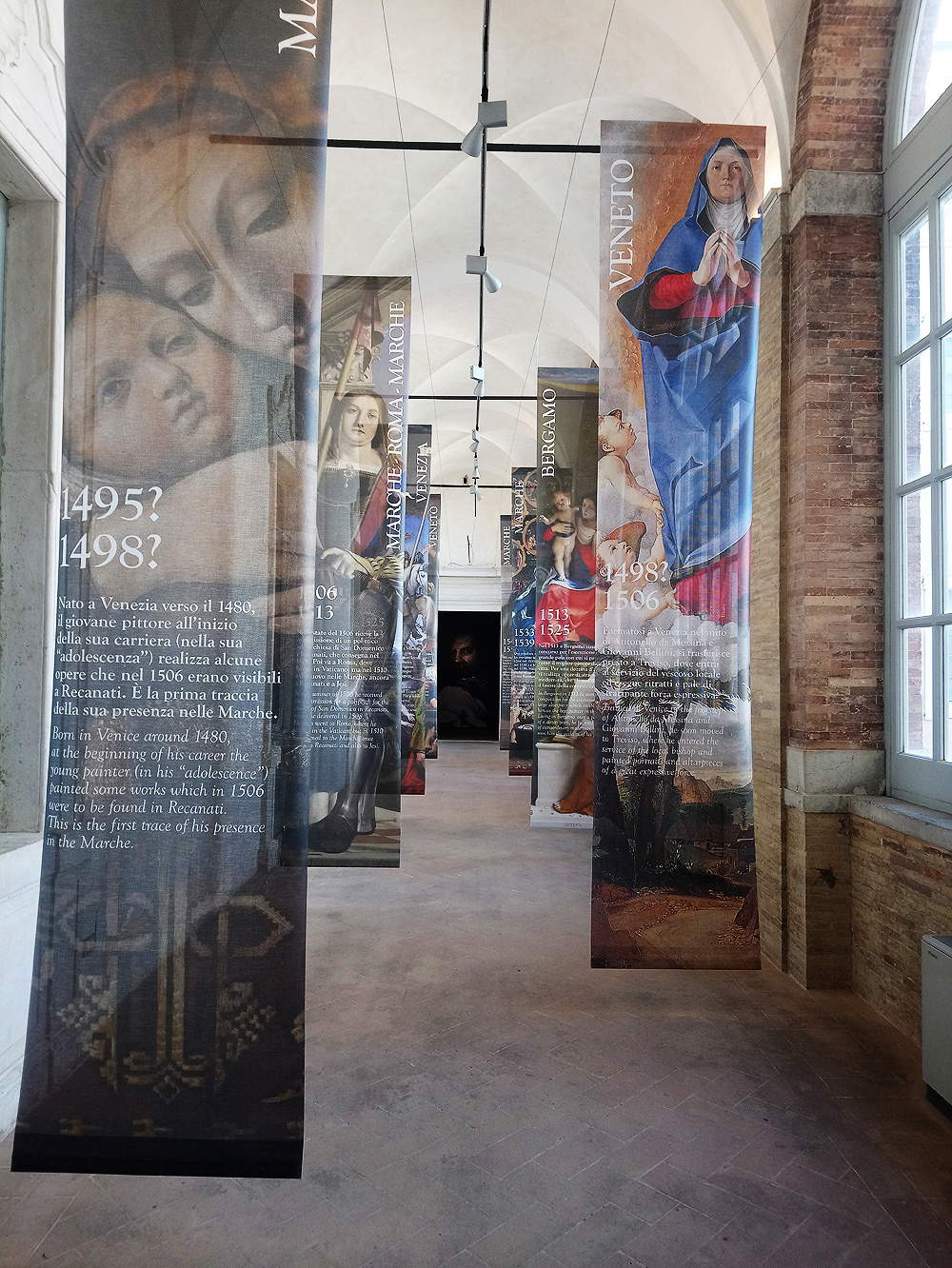 |
| The scenic entrance to the exhibition Lorenzo Lotto. The Lure of the Marche |
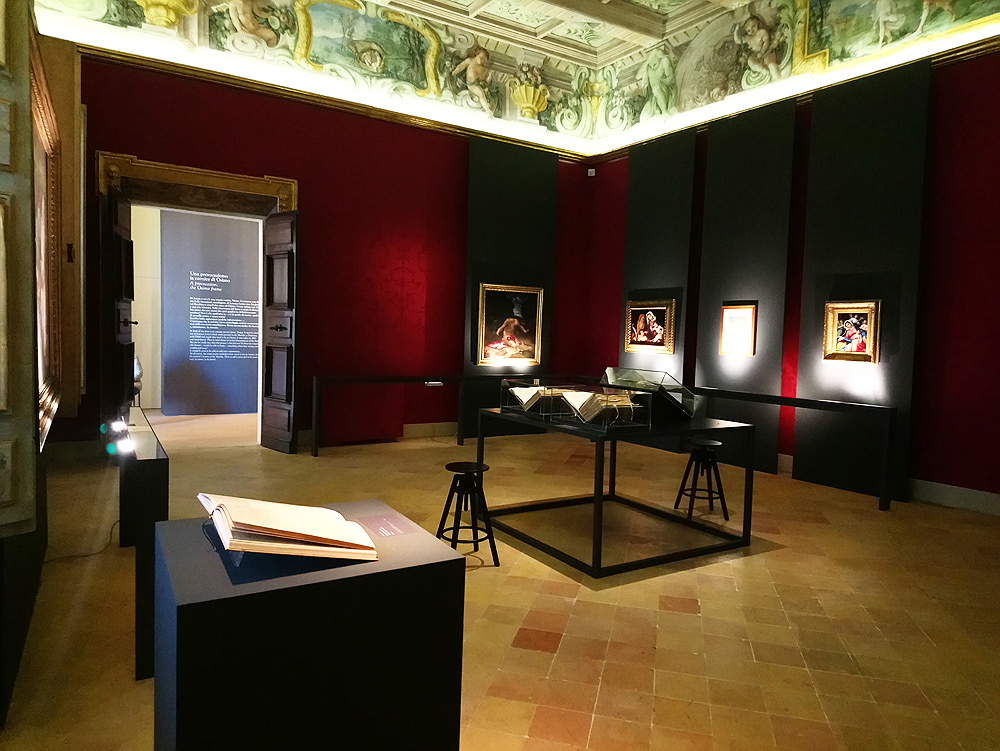 |
| A room of the exhibition: note the total respect and minimal encumbrance of the historic rooms of Palazzo Buonaccorsi |
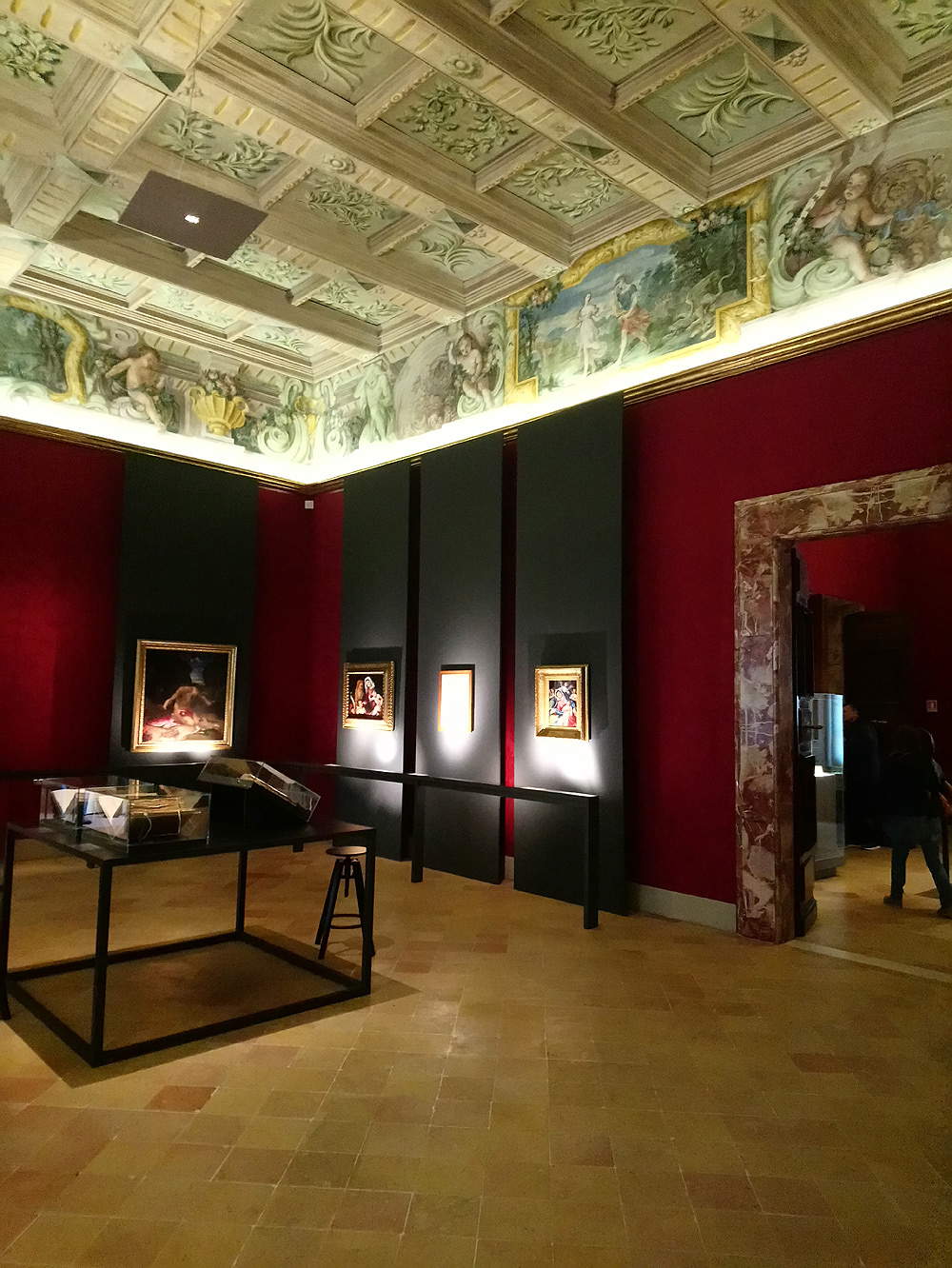 |
| Hall of the exhibition Lorenzo Lotto. The lure of Le Marche |
Having established the project, it is then necessary to imagine how to make it concrete. In the case of the exhibition on Lorenzo Lotto, a list of the works to be moved to Macerata was first drawn up, and the necessary discussions with the lenders were started as soon as possible, also because, in many cases, these were important international institutes with which to initiate or continue collaborative relationships. It should be emphasized that, as a rule, if the exhibition project has a solid scientific basis, if the works requested on loan find a serious justification within the framework of the exhibition itinerary, and if there are no risks that could threaten the transfer of the works, the curators of an exhibition do not encounter particular difficulties on the part of the institutions that have to temporarily deprive themselves of the requested objects. Such was the case with Lorenzo Lotto. The Lure of the Marches: even if one could not count on the loan of some paintings that had already been granted to the Madrid and London exhibition (it is worth noting that for a work of the 15th or 16th century, a journey, of whatever distance or duration, always represents a very delicate moment in its life, and one must also consider that certain works are iconic for their museums: consequently, it is safe to imagine that a museum would not want to be without such works for long.), the real “possibility of bringing together a significant collection,” Dal Pozzolo pointed out, led the project to garner “plaudits and a willingness in principle” at some institutions that held “key pieces.” Of course, the responses were not immediate: when organizing an exhibition, it is necessary to move well in advance to give lenders a chance to evaluate the project, decide whether or not to lend the works and then take all those actions necessary to protect the pieces. This is a process that takes many months to finalize in all its terms.
In order for the feedback from lending parties to be positive, an exhibition must also rely on a solid and scientifically credible research “staff” to ensure the layout of the exhibition and its catalog. Perhaps the importance of the catalog, which in so many exhibitions is now increasingly a minor frill, cannot be emphasized enough: yet, as Dal Pozzolo has also well pointed out, how important the catalog is in the economy of an original exhibition “is indicated by the fact that not infrequently the best exhibitions arise from the form that the catalogs set for them take, rather than vice versa.” In the case of the Macerata exhibition, the research team that would be in charge of the catalog (consisting of university professors: Annamaria Ambrosini Massari, Francesca Coltrinari, Alessandro Delpriori, Ottavia Niccoli, and Francesco De Carolis), an integral part of the exhibition’s scientific committee (which in addition to the aforementioned included five other scholars: Marina Massa, Marta Paraventi, Giuliana Pascucci, Vito Punzi and Lucia Tancredi, all of whom were involved at a later stage) envisioned an approach that would take into account, on the one hand, the works on display and, on the other, those found in the area in order to propose “continuous interwoven cross-references” between one and the other. In addition, thought was given to a necessary contextualization: not infrequently, monographic exhibitions (those, that is, dedicated to a single artist) present, usually at the opening, one or more sections aimed at reconstructing the historical, cultural, socio-economic environment in which the protagonist of the exhibition found himself working, and just as frequently, rooms are imagined that recount the artist’s critical fortune or misfortune, or the way in which later authors have grasped his legacy (these, on the other hand, are usually found at the conclusion of the itinerary). In Macerata, there was room for moments reserved for context and critical fortune, all of which were included at the opening of the itinerary: the first rooms first analyzed the figures of the protagonists who contributed to the historiographical recovery of the figure of Lorenzo Lotto, then the historical context of the Marche region in the late fifteenth century (all of which were then further developed in the catalog with ad hoc contributions). Contextualization implies the use not only of works of art, but also of documents (contracts, payment notes, memorials, newsletters and whatnot), which presupposes careful work on the sources. As for inheritance, since Lorenzo Lotto’s art did not have an immediate direct impact on coeval Marche painting, there was no provision in the exhibition for a moment of in-depth study on the subject (partly delegated, if anything, to Alessandro Delpriori’s essay in the catalog).
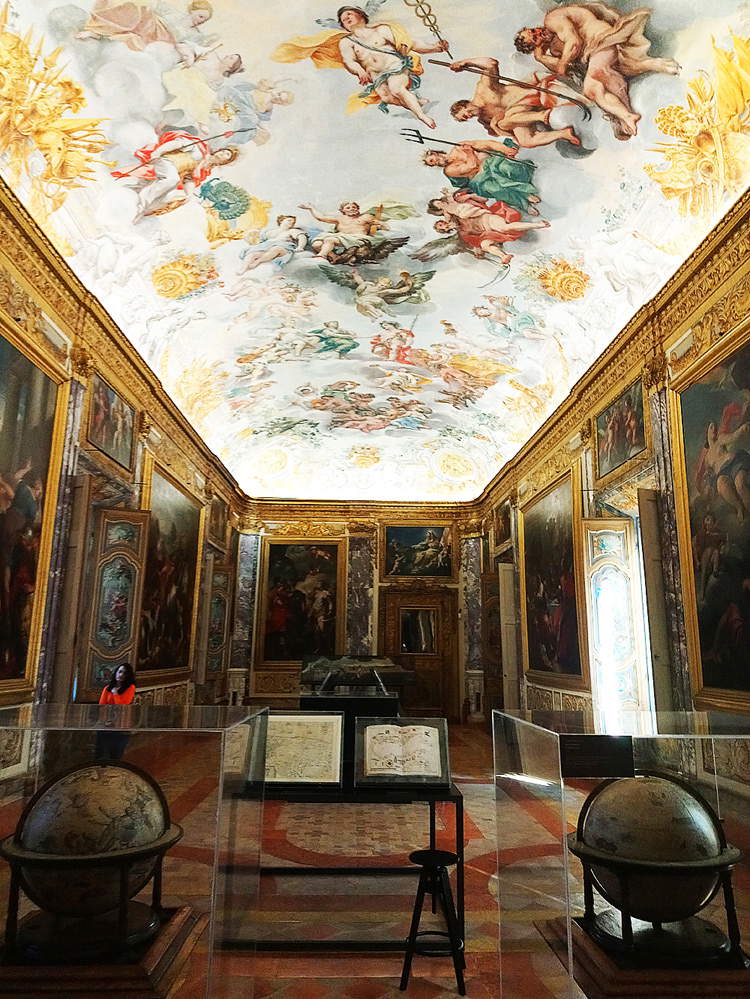 |
| Even a very difficult environment such as the Salone dell’Eneide in Palazzo Buonaccorsi was approached with due respect: it houses one of the sections of the exhibition on Lorenzo Lotto that delves into the cultural-historical context |
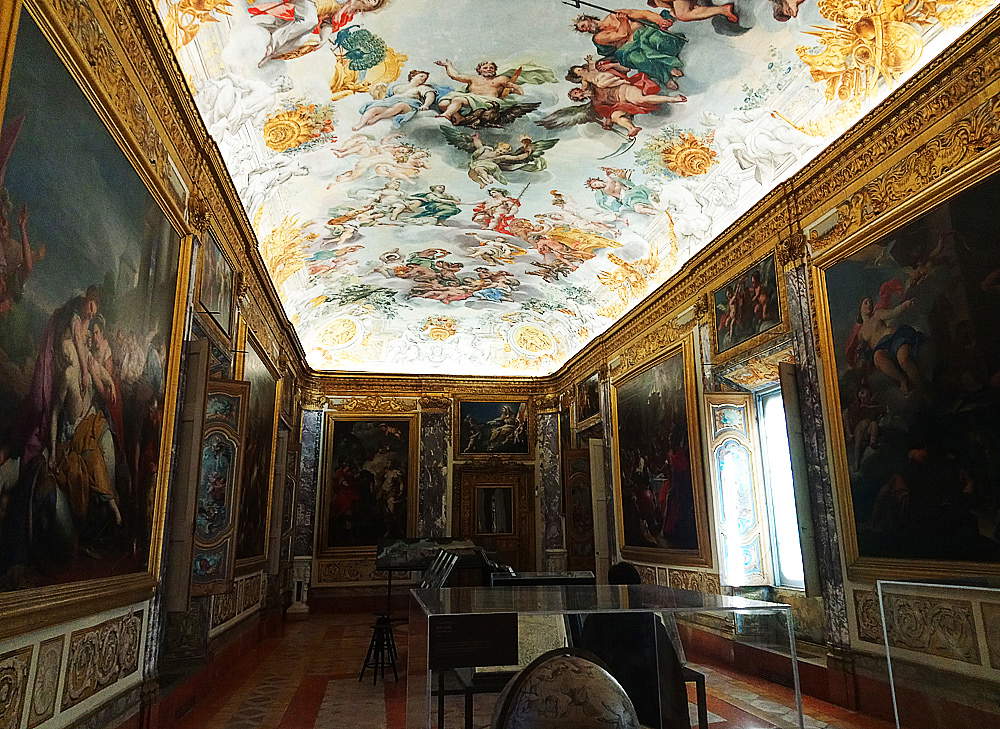 |
| The Salone dell’Eneide with the minimal arrangements for the exhibition on Lorenzo Lotto |
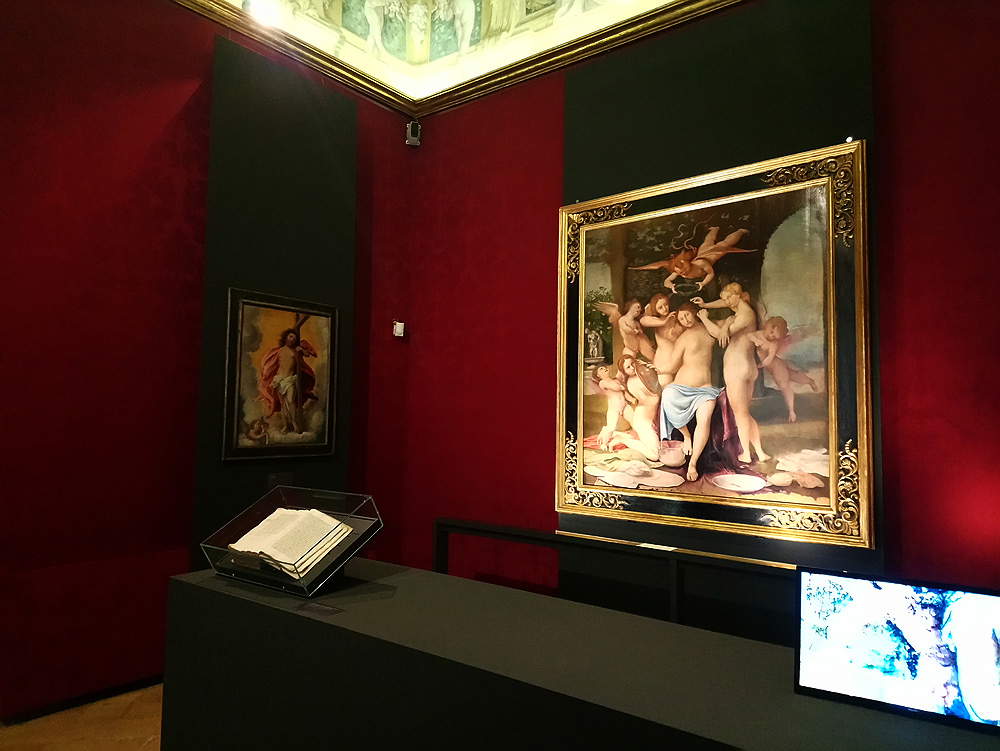 |
| Interaction between paintings, documents and multimedia supports |
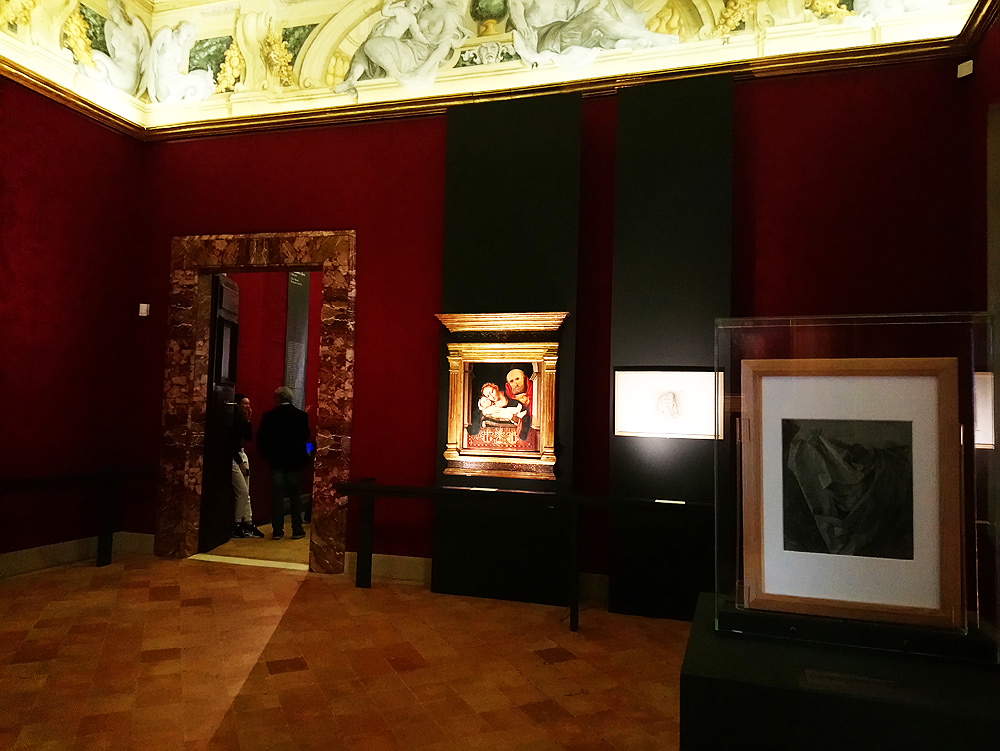 |
| Hall of the exhibition Lorenzo Lotto. The lure of the Marche region |
The choice of works to be exhibited implies several questions and confronts curator and scientific committee with several problems, both theoretical and practical. The latter have already been mentioned in part: the need to move in advance, the search for availability with the lending subjects, the setting up of the organizational machine that will take care of collaborative relationships, bureaucratic paperwork, insurance, transportation and whatever else is necessary to ensure that the loan proceeds in the best possible way. Some of the problems of a theoretical nature (which, of course, also have practical implications) have been well summarized in Progetto Lotto: the difficulty in establishing the most correct chronological sequence of the exhibition (the Macerata exhibition, in fact, was based on a chronological structure), the substantial impossibility of reasoning about “dark” periods for which we have neither works nor documents available, the presence of numerous unknowns that make it difficult to explain why a given work is related to another work, and so on. Several problems remain unsolvable, and the task of the scientific committee is to “recover and arrange the necessary pieces to draw a balanced overall path” in order to offer an accurate reconstruction, and in such a way that new facts about the artist and his environment are produced. In the case of the exhibition on Lorenzo Lotto, it was also decided that the exhibition would be followed by an international scholarly conference (promoted, specifically, by Francesca Coltrinari) that could take stock of the situation (this, too, is far from infrequent: thinking of the most important exhibitions of the year in Italy, the most recent was the conference organized as part of the two exhibitions on Tintoretto in Venice).
The choice of the exhibition venue is therefore identified on the basis of, first of all, technical elements: the location of the building, compliance with the safety standards set by national and international regulations, the size, capacity and condition of the halls, the presence of suitable environments for reception and services (ticket office, bookshop, checkroom, conference room). And then there are reasons of opportunity: in the case of the Lorenzo Lotto exhibition, Macerata was chosen because it is a municipality located in the earthquake crater and therefore a highly symbolic center. And Palazzo Buonaccorsi as a historical venue of great value (it must also be said that, with great intelligence, it was decided not to conceal frescoes and ancient tapestries with panels, as unfortunately happens more and more frequently). Then the design of the exhibition design is entrusted to a specialized studio (that of the architect Luca Schiavoni in the example of the exhibition on Lorenzo Lotto), the arrangement of the works is studied, and, finally, the collateral activities, the valorization paths, as well as all the necessary tools to ensure that the exhibition reaches the public (didactic and didactic apparatus, guided tours, press office, and so on) are developed. The exhibition is thus ready to open its doors to the public: and at the moment when the last piece of the mosaic reaches its position, it is finally possible to assess whether the final result, quoting again from Enrico Maria Dal Pozzolo’s contribution, is “consistent with the principles that had been set and satisfactory for the legitimate expectations of the public.”
Warning: the translation into English of the original Italian article was created using automatic tools. We undertake to review all articles, but we do not guarantee the total absence of inaccuracies in the translation due to the program. You can find the original by clicking on the ITA button. If you find any mistake,please contact us.